Deck 4: Market Failures Caused by Externalities Asymmetric Information
سؤال
سؤال
سؤال
سؤال
سؤال
سؤال
سؤال
سؤال
سؤال
سؤال
سؤال
سؤال
سؤال
سؤال
سؤال
سؤال
سؤال
سؤال
سؤال
سؤال
سؤال
سؤال
سؤال
سؤال
سؤال
سؤال
سؤال
سؤال
سؤال
سؤال
سؤال
سؤال
سؤال
سؤال
سؤال
سؤال
سؤال
سؤال
سؤال
سؤال
سؤال
سؤال
سؤال
سؤال
سؤال
سؤال
سؤال
سؤال
سؤال
سؤال
سؤال
سؤال
سؤال
سؤال
سؤال
سؤال
سؤال
سؤال
سؤال
سؤال
سؤال
سؤال
سؤال
سؤال
سؤال
سؤال
سؤال
سؤال
سؤال
سؤال
سؤال
سؤال
سؤال
سؤال
سؤال
سؤال
سؤال
سؤال
سؤال
سؤال

فتح الحزمة
قم بالتسجيل لفتح البطاقات في هذه المجموعة!
Unlock Deck
Unlock Deck
1/229
العب
ملء الشاشة (f)
Deck 4: Market Failures Caused by Externalities Asymmetric Information
1
When the marginal benefits exceed the marginal costs of producing a product, then allocative efficiency is not achieved in the market.
True
2
Professor Gullible agreed to cancel the final examination if students promised to study for it anyway. The concept of moral hazard would predict that it is unlikely that students will study for the exam.
True
3
The principle that private negotiation can resolve potential externalities without resorting to government intervention is known as the Coase theorem.
True
4
An improvement in the technology of pollution control is likely to increase society's optimal amount of pollution abatement.

فتح الحزمة
افتح القفل للوصول البطاقات البالغ عددها 229 في هذه المجموعة.
فتح الحزمة
k this deck
5
Insurance co-pays and deductibles are methods used by insurance companies to reduce moral hazard.

فتح الحزمة
افتح القفل للوصول البطاقات البالغ عددها 229 في هذه المجموعة.
فتح الحزمة
k this deck
6
Assume that there are four consumers A, B, C, and D, and the prices that each of them is willing to pay for a glass of lemonade is, respectively, $1.50, $1.20, $1.00, and $0.90. If the actual price of lemonade is $1.00 per glass, then consumer surplus in this market will be $0.70.

فتح الحزمة
افتح القفل للوصول البطاقات البالغ عددها 229 في هذه المجموعة.
فتح الحزمة
k this deck
7
The moral hazard problem is the tendency of some parties to a contract to alter their behavior as a result of the contract in ways that are costly to the other party.

فتح الحزمة
افتح القفل للوصول البطاقات البالغ عددها 229 في هذه المجموعة.
فتح الحزمة
k this deck
8
Asymmetric information always results in adverse selection.

فتح الحزمة
افتح القفل للوصول البطاقات البالغ عددها 229 في هذه المجموعة.
فتح الحزمة
k this deck
9
Society's optimal amount of pollution abatement is where society's marginal benefit of abatement is zero.

فتح الحزمة
افتح القفل للوصول البطاقات البالغ عددها 229 في هذه المجموعة.
فتح الحزمة
k this deck
10
Along a supply curve, product price and producer surplus are inversely related.

فتح الحزمة
افتح القفل للوصول البطاقات البالغ عددها 229 في هذه المجموعة.
فتح الحزمة
k this deck
11
The adverse selection problem is the tendency for insured drivers to drive recklessly.

فتح الحزمة
افتح القفل للوصول البطاقات البالغ عددها 229 في هذه المجموعة.
فتح الحزمة
k this deck
12
Allocative efficiency occurs where the collective sum of consumer and producer surplus is at a maximum.

فتح الحزمة
افتح القفل للوصول البطاقات البالغ عددها 229 في هذه المجموعة.
فتح الحزمة
k this deck
13
Along a demand curve, product price and consumer surplus are inversely related.

فتح الحزمة
افتح القفل للوصول البطاقات البالغ عددها 229 في هذه المجموعة.
فتح الحزمة
k this deck
14
A significant amount of positive consumer surplus is the reason why sometimes a shopper regrets having bought a particular item.

فتح الحزمة
افتح القفل للوصول البطاقات البالغ عددها 229 في هذه المجموعة.
فتح الحزمة
k this deck
15
Society's marginal cost of pollution abatement curve slopes upward because of the law of diminishing marginal utility.

فتح الحزمة
افتح القفل للوصول البطاقات البالغ عددها 229 في هذه المجموعة.
فتح الحزمة
k this deck
16
If the consumer is willing to pay a price higher than the actual price of a product, then the consumer will not buy the product because the consumer surplus will be negative.

فتح الحزمة
افتح القفل للوصول البطاقات البالغ عددها 229 في هذه المجموعة.
فتح الحزمة
k this deck
17
When the total consumer and producer surplus is at a maximum, the deadweight loss in the market is zero.

فتح الحزمة
افتح القفل للوصول البطاقات البالغ عددها 229 في هذه المجموعة.
فتح الحزمة
k this deck
18
If car makers are required to install gadgets to improve the cleanliness of car-exhaust, we would expect the equilibrium quantity in the car market to decrease.

فتح الحزمة
افتح القفل للوصول البطاقات البالغ عددها 229 في هذه المجموعة.
فتح الحزمة
k this deck
19
When there is allocative efficiency in a market, the buyers' maximum willingness to pay for the last unit traded is equal to the sellers' minimum acceptable price for that unit.

فتح الحزمة
افتح القفل للوصول البطاقات البالغ عددها 229 في هذه المجموعة.
فتح الحزمة
k this deck
20
Allocative efficiency occurs where (for the last unit)maximum willingness to pay exceeds minimum acceptable price by the greatest amount.

فتح الحزمة
افتح القفل للوصول البطاقات البالغ عددها 229 في هذه المجموعة.
فتح الحزمة
k this deck
21
The licensing and regulation of financial advisers is one way by which the government tries to deal with the problem of inadequate information that financial firms have about their customers.

فتح الحزمة
افتح القفل للوصول البطاقات البالغ عددها 229 في هذه المجموعة.
فتح الحزمة
k this deck
22
An effective antipollution policy from the economic perspective requires that all pollution be eliminated and banned.

فتح الحزمة
افتح القفل للوصول البطاقات البالغ عددها 229 في هذه المجموعة.
فتح الحزمة
k this deck
23
There are no external costs with being on the roadways during peak driving hours; there are only private costs that include your gasoline and opportunity cost of time spent in traffic.

فتح الحزمة
افتح القفل للوصول البطاقات البالغ عددها 229 في هذه المجموعة.
فتح الحزمة
k this deck
24
In a well-functioning cap-and-trade system for pollution rights, society benefits because pollution will be brought down to insignificant levels.

فتح الحزمة
افتح القفل للوصول البطاقات البالغ عددها 229 في هذه المجموعة.
فتح الحزمة
k this deck
25
When the government bails out large banks when the banks become unstable, it could lead to a moral hazard problem in banking.

فتح الحزمة
افتح القفل للوصول البطاقات البالغ عددها 229 في هذه المجموعة.
فتح الحزمة
k this deck
26
The Coase theorem suggests that the government does not have to be involved at all in resolving a market failure due to externalities.

فتح الحزمة
افتح القفل للوصول البطاقات البالغ عددها 229 في هذه المجموعة.
فتح الحزمة
k this deck
27
An example of an adverse selection problem is in insurance, where the people most likely to claim insurance payouts are the people who will seek to buy the most generous policies.

فتح الحزمة
افتح القفل للوصول البطاقات البالغ عددها 229 في هذه المجموعة.
فتح الحزمة
k this deck
28
When the government bails out failing banks, it creates a moral hazard problem; but when the government bails out homeowners who are defaulting on their mortgages, there is no moral hazard problem.

فتح الحزمة
افتح القفل للوصول البطاقات البالغ عددها 229 في هذه المجموعة.
فتح الحزمة
k this deck
29
If the lumber companies are required to internalize the negative externalities of deforestation, then we should expect the equilibrium price of wooden furniture to decrease.

فتح الحزمة
افتح القفل للوصول البطاقات البالغ عددها 229 في هذه المجموعة.
فتح الحزمة
k this deck
30
When critics of unemployment insurance claim that some of the unemployed are not exerting much effort to find jobs because of the unemployment benefits, they are referring to the moral hazard problem.

فتح الحزمة
افتح القفل للوصول البطاقات البالغ عددها 229 في هذه المجموعة.
فتح الحزمة
k this deck
31
People with high opportunity costs for time won't mind sitting in traffic.

فتح الحزمة
افتح القفل للوصول البطاقات البالغ عددها 229 في هذه المجموعة.
فتح الحزمة
k this deck
32
eBay and Amazon provide "sellers' ratings" information based on the experiences of past buyers. This is to help resolve the adverse selection problem faced by potential buyers.

فتح الحزمة
افتح القفل للوصول البطاقات البالغ عددها 229 في هذه المجموعة.
فتح الحزمة
k this deck
33
Asymmetric information occurs when the two parties in a market transaction do not have the same amount of information regarding the product or process involved in the transaction.

فتح الحزمة
افتح القفل للوصول البطاقات البالغ عددها 229 في هذه المجموعة.
فتح الحزمة
k this deck
34
Jennifer buys a piece of costume jewelry for $30, for which she was willing to pay $35. The minimum acceptable price to the seller, Nathan, was $15. Jennifer experiences a
A)consumer surplus of $15, and Nathan experiences a producer surplus of $20.
B)producer surplus of $5, and Nathan experiences a consumer surplus of $15.
C)producer surplus of $65, and Nathan experiences a producer surplus of $50.
D)consumer surplus of $5, and Nathan experiences a producer surplus of $15.
E)consumer surplus of $5, and Nathan experiences a consumer surplus of $5.
A)consumer surplus of $15, and Nathan experiences a producer surplus of $20.
B)producer surplus of $5, and Nathan experiences a consumer surplus of $15.
C)producer surplus of $65, and Nathan experiences a producer surplus of $50.
D)consumer surplus of $5, and Nathan experiences a producer surplus of $15.
E)consumer surplus of $5, and Nathan experiences a consumer surplus of $5.

فتح الحزمة
افتح القفل للوصول البطاقات البالغ عددها 229 في هذه المجموعة.
فتح الحزمة
k this deck
35
In dealing with market failures, the government always bases its decisions on economic analysis of marginal cost and marginal benefit.

فتح الحزمة
افتح القفل للوصول البطاقات البالغ عددها 229 في هذه المجموعة.
فتح الحزمة
k this deck
36
Better Business Bureaus in various cities exist partly in order to try to deal with inadequate buyer information about sellers.

فتح الحزمة
افتح القفل للوصول البطاقات البالغ عددها 229 في هذه المجموعة.
فتح الحزمة
k this deck
37
A moral hazard problem occurs before a transaction-when people alter their behavior before they sign a contract, imposing costs on the other party.

فتح الحزمة
افتح القفل للوصول البطاقات البالغ عددها 229 في هذه المجموعة.
فتح الحزمة
k this deck
38
Production subsidies are a way of internalizing external costs among polluting firms.

فتح الحزمة
افتح القفل للوصول البطاقات البالغ عددها 229 في هذه المجموعة.
فتح الحزمة
k this deck
39
Adverse selection is when someone with home insurance decides to take the chance that a dying tree would fall on the garage, rather than spend the money to have the tree cut down.

فتح الحزمة
افتح القفل للوصول البطاقات البالغ عددها 229 في هذه المجموعة.
فتح الحزمة
k this deck
40
The government should choose pollution abatement for all sources of pollution where the marginal benefit exceeds the marginal cost of that action.

فتح الحزمة
افتح القفل للوصول البطاقات البالغ عددها 229 في هذه المجموعة.
فتح الحزمة
k this deck
41
Market failure is said to occur whenever
A)competitive markets do not allocate resources in the most economically desirable way.
B)prices rise.
C)some consumers who want a good do not obtain it because the price is higher than they are willing to pay.
D)government intervenes in the functioning of competitive markets.
A)competitive markets do not allocate resources in the most economically desirable way.
B)prices rise.
C)some consumers who want a good do not obtain it because the price is higher than they are willing to pay.
D)government intervenes in the functioning of competitive markets.

فتح الحزمة
افتح القفل للوصول البطاقات البالغ عددها 229 في هذه المجموعة.
فتح الحزمة
k this deck
42
 Refer to the provided table. What is the total producer surplus in the market for all producers A, B, C, D, and E?
Refer to the provided table. What is the total producer surplus in the market for all producers A, B, C, D, and E?A)$16
B)$34
C)$29
D)$31
E)$19

فتح الحزمة
افتح القفل للوصول البطاقات البالغ عددها 229 في هذه المجموعة.
فتح الحزمة
k this deck
43
Other things equal, a fall in the market price caused by a change in supply will
A)increase consumer surplus.
B)decrease consumer surplus.
C)increase producer surplus while leaving consumer surplus unchanged.
D)decrease producer surplus while leaving consumer surplus unchanged.
A)increase consumer surplus.
B)decrease consumer surplus.
C)increase producer surplus while leaving consumer surplus unchanged.
D)decrease producer surplus while leaving consumer surplus unchanged.

فتح الحزمة
افتح القفل للوصول البطاقات البالغ عددها 229 في هذه المجموعة.
فتح الحزمة
k this deck
44
Jennifer buys a piece of costume jewelry for $33, for which she was willing to pay $42. The minimum acceptable price to the seller, Nathan, was $30. Jennifer experiences a
A)a consumer surplus of $12, and Nathan experiences a producer surplus of $3.
B)a producer surplus of $9, and Nathan experiences a consumer surplus of $3.
C)a consumer surplus of $9, and Nathan experiences a producer surplus of $3.
D)a producer surplus of $9, and Nathan experiences a producer surplus of $12.
A)a consumer surplus of $12, and Nathan experiences a producer surplus of $3.
B)a producer surplus of $9, and Nathan experiences a consumer surplus of $3.
C)a consumer surplus of $9, and Nathan experiences a producer surplus of $3.
D)a producer surplus of $9, and Nathan experiences a producer surplus of $12.

فتح الحزمة
افتح القفل للوصول البطاقات البالغ عددها 229 في هذه المجموعة.
فتح الحزمة
k this deck
45
Consumer surplus
A)is the difference between the maximum prices consumers are willing to pay for a product and the lower equilibrium price.
B)is the difference between the maximum prices consumers are willing to pay for a product and the minimum prices producers are willing to accept.
C)is the difference between the minimum prices producers are willing to accept for a product and the higher equilibrium price.
D)rises as equilibrium price rises.
A)is the difference between the maximum prices consumers are willing to pay for a product and the lower equilibrium price.
B)is the difference between the maximum prices consumers are willing to pay for a product and the minimum prices producers are willing to accept.
C)is the difference between the minimum prices producers are willing to accept for a product and the higher equilibrium price.
D)rises as equilibrium price rises.

فتح الحزمة
افتح القفل للوصول البطاقات البالغ عددها 229 في هذه المجموعة.
فتح الحزمة
k this deck
46
What two conditions must hold for a competitive market to produce efficient outcomes?
A)Demand curves must reflect all costs of production, and supply curves must reflect consumers' full willingness to pay.
B)Supply curves must reflect all costs of production, and demand curves must reflect consumers' full willingness to pay.
C)Firms must minimize production costs, and consumers must minimize total expenditures.
D)Firms must maximize profits, and consumers must all pay prices equal to their maximum willingness to pay.
A)Demand curves must reflect all costs of production, and supply curves must reflect consumers' full willingness to pay.
B)Supply curves must reflect all costs of production, and demand curves must reflect consumers' full willingness to pay.
C)Firms must minimize production costs, and consumers must minimize total expenditures.
D)Firms must maximize profits, and consumers must all pay prices equal to their maximum willingness to pay.

فتح الحزمة
افتح القفل للوصول البطاقات البالغ عددها 229 في هذه المجموعة.
فتح الحزمة
k this deck
47
Amanda buys a ruby for $240 for which she was willing to pay $340. The minimum acceptable price to the seller, Tony, was $190. Amanda experiences
A)a consumer surplus of $580, and Tony experiences a producer surplus of $200.
B)a consumer surplus of $100, and Tony experiences a consumer surplus of $150.
C)a producer surplus of $200, and Tony experiences a consumer surplus of $100.
D)a consumer surplus of $100, and Tony experiences a producer surplus of $50.
E)a producer surplus of $100, and Tony experiences a consumer surplus of $190.
A)a consumer surplus of $580, and Tony experiences a producer surplus of $200.
B)a consumer surplus of $100, and Tony experiences a consumer surplus of $150.
C)a producer surplus of $200, and Tony experiences a consumer surplus of $100.
D)a consumer surplus of $100, and Tony experiences a producer surplus of $50.
E)a producer surplus of $100, and Tony experiences a consumer surplus of $190.

فتح الحزمة
افتح القفل للوصول البطاقات البالغ عددها 229 في هذه المجموعة.
فتح الحزمة
k this deck
48
 Refer to the diagram. Assuming equilibrium price P1, consumer surplus is represented by areas
Refer to the diagram. Assuming equilibrium price P1, consumer surplus is represented by areasA)a + b.
B)a + b + c + d.
C)c + d.
D)a + c.

فتح الحزمة
افتح القفل للوصول البطاقات البالغ عددها 229 في هذه المجموعة.
فتح الحزمة
k this deck
49
A producer's minimum acceptable price for a particular unit of a good
A)is the same for all units of the good.
B)will, for most units produced, equal the maximum that consumers are willing to pay for the good.
C)equals the marginal cost of producing that particular unit.
D)must cover the wages, rent, and interest payments necessary to produce the good but need not include profit.
A)is the same for all units of the good.
B)will, for most units produced, equal the maximum that consumers are willing to pay for the good.
C)equals the marginal cost of producing that particular unit.
D)must cover the wages, rent, and interest payments necessary to produce the good but need not include profit.

فتح الحزمة
افتح القفل للوصول البطاقات البالغ عددها 229 في هذه المجموعة.
فتح الحزمة
k this deck
50
Graphically, producer surplus is measured as the area
A)under the demand curve and below the actual price.
B)under the demand curve and above the actual price.
C)above the supply curve and above the actual price.
D)above the supply curve and below the actual price.
A)under the demand curve and below the actual price.
B)under the demand curve and above the actual price.
C)above the supply curve and above the actual price.
D)above the supply curve and below the actual price.

فتح الحزمة
افتح القفل للوصول البطاقات البالغ عددها 229 في هذه المجموعة.
فتح الحزمة
k this deck
51
Market failures
A)are only a concern when they result in prices that are too high.
B)apply exclusively to situations where markets do not produce any of an economically desirable good.
C)result in overproduction or underproduction of a good.
D)result from government interference in markets.
A)are only a concern when they result in prices that are too high.
B)apply exclusively to situations where markets do not produce any of an economically desirable good.
C)result in overproduction or underproduction of a good.
D)result from government interference in markets.

فتح الحزمة
افتح القفل للوصول البطاقات البالغ عددها 229 في هذه المجموعة.
فتح الحزمة
k this deck
52
The minimum acceptable price for a product that producer Sam is willing to receive is 10. The price he could get for the product in the market is 15. How much is Sam's producer surplus?
A)25
B)15
C)more than $10
D)5
E)150
A)25
B)15
C)more than $10
D)5
E)150

فتح الحزمة
افتح القفل للوصول البطاقات البالغ عددها 229 في هذه المجموعة.
فتح الحزمة
k this deck
53
In the market for a particular pair of shoes, Geri is willing to pay $75 for a pair, while Jane is willing to pay $95 for a pair. The actual price that each has to pay for a pair of these shoes is $65. What is the total amount of the two women's combined consumer surplus?
A)$20
B)less than $20
C)$195
D)$10
E)$40
A)$20
B)less than $20
C)$195
D)$10
E)$40

فتح الحزمة
افتح القفل للوصول البطاقات البالغ عددها 229 في هذه المجموعة.
فتح الحزمة
k this deck
54
Producer surplus is the difference between
A)the maximum prices consumers are willing to pay for a product and the lower equilibrium price.
B)the quantity supplied and quantity demanded at an above equilibrium price.
C)the minimum prices producers are willing to accept for a product and the higher equilibrium price.
D)the maximum prices consumers are willing to pay for a product and the minimum prices producers are willing to accept.
A)the maximum prices consumers are willing to pay for a product and the lower equilibrium price.
B)the quantity supplied and quantity demanded at an above equilibrium price.
C)the minimum prices producers are willing to accept for a product and the higher equilibrium price.
D)the maximum prices consumers are willing to pay for a product and the minimum prices producers are willing to accept.

فتح الحزمة
افتح القفل للوصول البطاقات البالغ عددها 229 في هذه المجموعة.
فتح الحزمة
k this deck
55
Amanda buys a ruby for $330 for which she was willing to pay $340. The minimum acceptable price to the seller, Tony, was $140. Amanda experiences
A)a consumer surplus of $10, and Tony experiences a producer surplus of $190.
B)a producer surplus of $200, and Tony experiences a consumer surplus of $10.
C)a consumer surplus of $670, and Tony experiences a producer surplus of $200.
D)a producer surplus of $10, and Tony experiences a consumer surplus of $190.
A)a consumer surplus of $10, and Tony experiences a producer surplus of $190.
B)a producer surplus of $200, and Tony experiences a consumer surplus of $10.
C)a consumer surplus of $670, and Tony experiences a producer surplus of $200.
D)a producer surplus of $10, and Tony experiences a consumer surplus of $190.

فتح الحزمة
افتح القفل للوصول البطاقات البالغ عددها 229 في هذه المجموعة.
فتح الحزمة
k this deck
56
Graphically, if the supply and demand curves are linear, consumer surplus is measured as the triangle
A)under the demand curve and below the actual price.
B)under the demand curve and above the actual price.
C)above the supply curve and above the actual price.
D)above the supply curve and below the actual price.
A)under the demand curve and below the actual price.
B)under the demand curve and above the actual price.
C)above the supply curve and above the actual price.
D)above the supply curve and below the actual price.

فتح الحزمة
افتح القفل للوصول البطاقات البالغ عددها 229 في هذه المجموعة.
فتح الحزمة
k this deck
57
Charlie is willing to pay $12 for a T-shirt that is priced at $10. If Charlie buys the T-shirt, then his consumer surplus is
A)$2.
B)$12.
C)$22.
D)more than $10.
E)$120.
A)$2.
B)$12.
C)$22.
D)more than $10.
E)$120.

فتح الحزمة
افتح القفل للوصول البطاقات البالغ عددها 229 في هذه المجموعة.
فتح الحزمة
k this deck
58
 Refer to the provided table. The surplus for Producer A is
Refer to the provided table. The surplus for Producer A isA)$7.
B)$6.
C)$19.
D)$4.
E)$13.

فتح الحزمة
افتح القفل للوصول البطاقات البالغ عددها 229 في هذه المجموعة.
فتح الحزمة
k this deck
59
Assume that there are four consumers A, B, C, and D, and the prices that each of them is willing to pay for a glass of lemonade is, respectively, $2.50, $2.25, $2.00, and $1.75. If the actual price of lemonade is $1.50 per glass, then consumer surplus in this market will be
A)$3.25.
B)$1.50.
C)$4.50.
D)$1.00.
E)$2.50.
A)$3.25.
B)$1.50.
C)$4.50.
D)$1.00.
E)$2.50.

فتح الحزمة
افتح القفل للوصول البطاقات البالغ عددها 229 في هذه المجموعة.
فتح الحزمة
k this deck
60
If the demand curve reflects consumers' full willingness to pay, and the supply curve reflects all costs of production, then which of the following is true?
A)The benefit surpluses shared between consumers and producers will be maximized.
B)The benefit surpluses received by consumers and producers will be equal.
C)There will be no consumer or producer surplus.
D)Consumer surplus will be maximized, and producer surplus will be minimized.
A)The benefit surpluses shared between consumers and producers will be maximized.
B)The benefit surpluses received by consumers and producers will be equal.
C)There will be no consumer or producer surplus.
D)Consumer surplus will be maximized, and producer surplus will be minimized.

فتح الحزمة
افتح القفل للوصول البطاقات البالغ عددها 229 في هذه المجموعة.
فتح الحزمة
k this deck
61
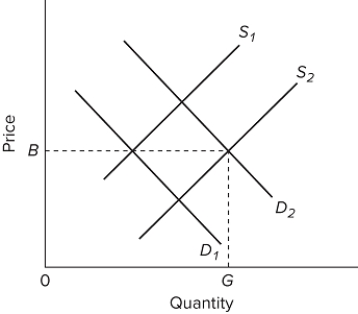 Refer to the competitive market diagram for product Z. Assume that the current market demand and supply curves for Z are D₁ and S₁. If there are substantial external benefits associated with the production of Z, then
Refer to the competitive market diagram for product Z. Assume that the current market demand and supply curves for Z are D₁ and S₁. If there are substantial external benefits associated with the production of Z, thenA)government can improve the allocation of resources by subsidizing consumers of Z.
B)government can improve the allocation of resources by imposing a per-unit tax on Z.
C)a government subsidy for producers of Z would ensure that consumers are paying directly for all of the benefits they receive from Z.
D)consumers are paying too much for the good.

فتح الحزمة
افتح القفل للوصول البطاقات البالغ عددها 229 في هذه المجموعة.
فتح الحزمة
k this deck
62
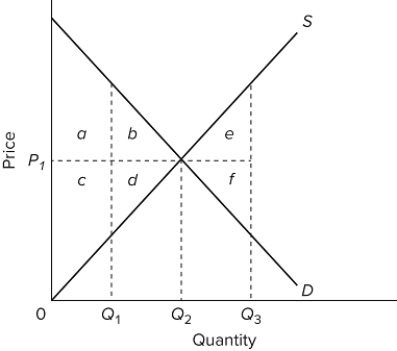 Refer to the diagram. If actual production and consumption occur at Q1,
Refer to the diagram. If actual production and consumption occur at Q1,A)efficiency is achieved.
B)consumer surplus is maximized.
C)an efficiency loss (or deadweight loss)of b + d occurs.
D)an efficiency loss (or deadweight loss)of e + d occurs.

فتح الحزمة
افتح القفل للوصول البطاقات البالغ عددها 229 في هذه المجموعة.
فتح الحزمة
k this deck
63
At the output where the combined amounts of consumer and producer surplus are largest,
A)the areas of consumer and producer surplus necessarily are equal.
B)the maximum willingness to pay for the last unit of output equals the minimum acceptable price of that unit of output.
C)consumer surplus exceeds producer surplus by the greatest amount.
D)marginal benefit exceeds marginal cost by the greatest amount.
A)the areas of consumer and producer surplus necessarily are equal.
B)the maximum willingness to pay for the last unit of output equals the minimum acceptable price of that unit of output.
C)consumer surplus exceeds producer surplus by the greatest amount.
D)marginal benefit exceeds marginal cost by the greatest amount.

فتح الحزمة
افتح القفل للوصول البطاقات البالغ عددها 229 في هذه المجموعة.
فتح الحزمة
k this deck
64
An efficiency loss (or deadweight loss)
A)is measured as the combined loss of consumer surplus and producer surplus from over- or underproducing.
B)results from producing a unit of output for which the maximum willingness to pay exceeds the minimum acceptable price.
C)can result from underproduction, but not from overproduction.
D)can result from overproduction, but not from underproduction.
A)is measured as the combined loss of consumer surplus and producer surplus from over- or underproducing.
B)results from producing a unit of output for which the maximum willingness to pay exceeds the minimum acceptable price.
C)can result from underproduction, but not from overproduction.
D)can result from overproduction, but not from underproduction.

فتح الحزمة
افتح القفل للوصول البطاقات البالغ عددها 229 في هذه المجموعة.
فتح الحزمة
k this deck
65
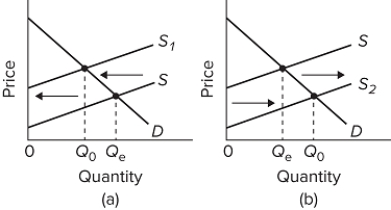 Refer to the diagrams for two separate product markets. Assume that society's optimal level of output in each market is Q₀ and that government purposely shifts the market supply curve from S to S₁ in diagram (a)on the left and from S to S₂ in diagram (b)on the right. The shift of the supply curve from S to S₁ in diagram (a)might be caused by a per-unit
Refer to the diagrams for two separate product markets. Assume that society's optimal level of output in each market is Q₀ and that government purposely shifts the market supply curve from S to S₁ in diagram (a)on the left and from S to S₂ in diagram (b)on the right. The shift of the supply curve from S to S₁ in diagram (a)might be caused by a per-unitA)subsidy paid to the producers of this product.
B)tax on the producers of this product.
C)subsidy paid to the buyers of this product.
D)tax on the buyers of this product.

فتح الحزمة
افتح القفل للوصول البطاقات البالغ عددها 229 في هذه المجموعة.
فتح الحزمة
k this deck
66
An efficiency loss (or deadweight loss)declines in size when a unit of output is produced for which
A)marginal cost exceeds marginal benefit.
B)maximum willingness to pay exceeds minimum acceptable price.
C)consumer surplus exceeds producer surplus.
D)producer surplus exceeds consumer surplus.
A)marginal cost exceeds marginal benefit.
B)maximum willingness to pay exceeds minimum acceptable price.
C)consumer surplus exceeds producer surplus.
D)producer surplus exceeds consumer surplus.

فتح الحزمة
افتح القفل للوصول البطاقات البالغ عددها 229 في هذه المجموعة.
فتح الحزمة
k this deck
67
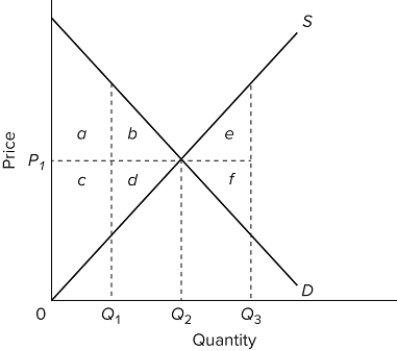 Refer to the diagram. The area that identifies the maximum sum of consumer surplus and producer surplus is
Refer to the diagram. The area that identifies the maximum sum of consumer surplus and producer surplus isA)a + b + c + d + e + f.
B)c + d + f.
C)a + b + e.
D)a + b + c + d.

فتح الحزمة
افتح القفل للوصول البطاقات البالغ عددها 229 في هذه المجموعة.
فتح الحزمة
k this deck
68
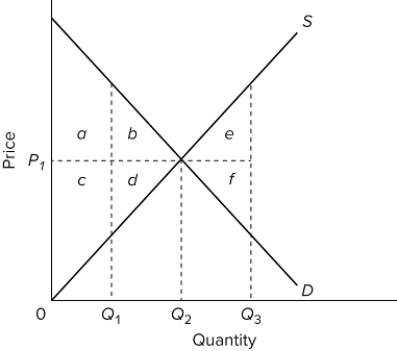 Refer to the diagram. Which of the following areas best represents the efficiency loss from underproduction?
Refer to the diagram. Which of the following areas best represents the efficiency loss from underproduction?A)a + c
B)e + f
C)a + b + c + d
D)b + d

فتح الحزمة
افتح القفل للوصول البطاقات البالغ عددها 229 في هذه المجموعة.
فتح الحزمة
k this deck
69
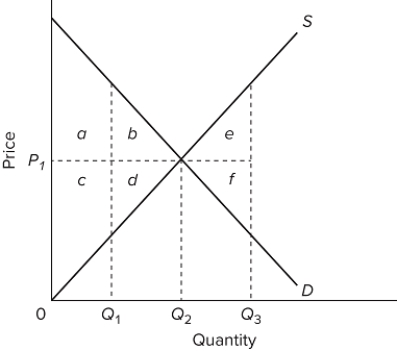 Refer to the diagram. If actual production and consumption occur at Q3,
Refer to the diagram. If actual production and consumption occur at Q3,A)efficiency is achieved.
B)an efficiency loss (or deadweight loss)of e + f occurs.
C)an efficiency loss (or deadweight loss)of a + b + c + d occurs.
D)an efficiency loss (or deadweight loss)of a + c occurs.

فتح الحزمة
افتح القفل للوصول البطاقات البالغ عددها 229 في هذه المجموعة.
فتح الحزمة
k this deck
70
Which of the following conditions does not need to occur for a market to achieve allocative efficiency?
A)Consumers' maximum willingness to pay equals producers' minimum acceptable price for the last unit of output.
B)The sum of producer and consumer surplus is maximized.
C)The total revenue received by producers equals the total cost of production.
D)The marginal benefit of the last unit produced equals the marginal cost of producing that unit.
A)Consumers' maximum willingness to pay equals producers' minimum acceptable price for the last unit of output.
B)The sum of producer and consumer surplus is maximized.
C)The total revenue received by producers equals the total cost of production.
D)The marginal benefit of the last unit produced equals the marginal cost of producing that unit.

فتح الحزمة
افتح القفل للوصول البطاقات البالغ عددها 229 في هذه المجموعة.
فتح الحزمة
k this deck
71
At the output level defining allocative efficiency,
A)the areas of consumer and producer surplus necessarily are equal.
B)marginal benefit exceeds marginal cost by the greatest amount.
C)consumer surplus exceeds producer surplus by the greatest amount.
D)the maximum willingness to pay for the last unit of output equals the minimum acceptable price of that unit of output.
A)the areas of consumer and producer surplus necessarily are equal.
B)marginal benefit exceeds marginal cost by the greatest amount.
C)consumer surplus exceeds producer surplus by the greatest amount.
D)the maximum willingness to pay for the last unit of output equals the minimum acceptable price of that unit of output.

فتح الحزمة
افتح القفل للوصول البطاقات البالغ عددها 229 في هذه المجموعة.
فتح الحزمة
k this deck
72
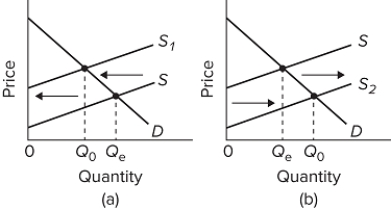 Refer to the diagrams for two separate product markets. Assume that society's optimal level of output in each market is Q₀ and that government purposely shifts the market supply curve from S to S₁ in diagram (a)on the left and from S to S₂ in diagram (b)on the right. The shift of the supply curve from S to S₂ in diagram (b)might be caused by a per-unit
Refer to the diagrams for two separate product markets. Assume that society's optimal level of output in each market is Q₀ and that government purposely shifts the market supply curve from S to S₁ in diagram (a)on the left and from S to S₂ in diagram (b)on the right. The shift of the supply curve from S to S₂ in diagram (b)might be caused by a per-unitA)subsidy paid to the producers of this product.
B)tax on the producers of this product.
C)subsidy paid to the buyers of this product.
D)tax on the buyers of this product.

فتح الحزمة
افتح القفل للوصول البطاقات البالغ عددها 229 في هذه المجموعة.
فتح الحزمة
k this deck
73
A negative externality or spillover cost occurs when
A)firms fail to achieve allocative efficiency.
B)firms fail to achieve productive efficiency.
C)the price of a good exceeds the marginal cost of producing it.
D)the total cost of producing a good exceeds the costs borne by the producer.
A)firms fail to achieve allocative efficiency.
B)firms fail to achieve productive efficiency.
C)the price of a good exceeds the marginal cost of producing it.
D)the total cost of producing a good exceeds the costs borne by the producer.

فتح الحزمة
افتح القفل للوصول البطاقات البالغ عددها 229 في هذه المجموعة.
فتح الحزمة
k this deck
74
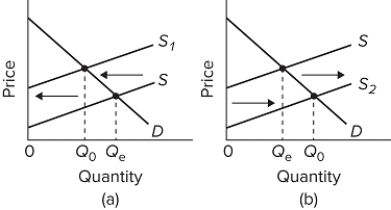 Refer to the diagrams for two separate product markets. Assume that society's optimal level of output in each market is Q₀ and that government purposely shifts the market supply curve from S to S₁ in diagram (a)on the left and from S to S₂ in diagram (b)on the right. We can conclude that the government is correcting for
Refer to the diagrams for two separate product markets. Assume that society's optimal level of output in each market is Q₀ and that government purposely shifts the market supply curve from S to S₁ in diagram (a)on the left and from S to S₂ in diagram (b)on the right. We can conclude that the government is correcting forA)negative externalities in diagram (a)and positive externalities in diagram (b).
B)positive externalities in diagram (a)and negative externalities in diagram (b).
C)negative externalities in both diagrams.
D)positive externalities in both diagrams.

فتح الحزمة
افتح القفل للوصول البطاقات البالغ عددها 229 في هذه المجموعة.
فتح الحزمة
k this deck
75
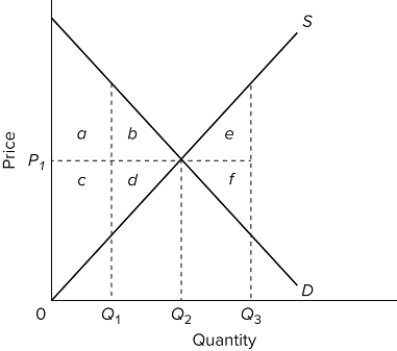 Refer to the diagram. If actual production and consumption occur at Q2,
Refer to the diagram. If actual production and consumption occur at Q2,A)efficiency is achieved.
B)an efficiency loss (or deadweight loss)of a + b + c + d occurs.
C)an efficiency loss (or deadweight loss)of a + c occurs.
D)an efficiency loss (or deadweight loss)of e + f occurs.

فتح الحزمة
افتح القفل للوصول البطاقات البالغ عددها 229 في هذه المجموعة.
فتح الحزمة
k this deck
76
 Refer to the diagram. Assuming equilibrium price P1, producer surplus is represented by areas
Refer to the diagram. Assuming equilibrium price P1, producer surplus is represented by areasA)a + b.
B)a + b + c + d.
C)c + d.
D)a + c.

فتح الحزمة
افتح القفل للوصول البطاقات البالغ عددها 229 في هذه المجموعة.
فتح الحزمة
k this deck
77
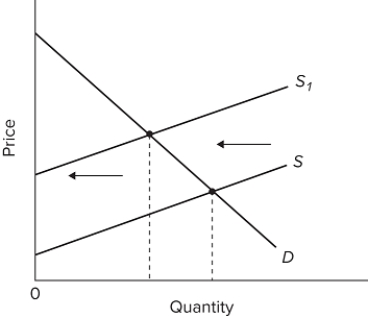 Refer to the diagram, in which S is the market supply curve and S₁ is a supply curve comprising all costs of production, including external costs. Assume that the number of people affected by these external costs is large. If the government wishes to establish an optimal allocation of resources in this market, it should
Refer to the diagram, in which S is the market supply curve and S₁ is a supply curve comprising all costs of production, including external costs. Assume that the number of people affected by these external costs is large. If the government wishes to establish an optimal allocation of resources in this market, it shouldA)not intervene because the market outcome is optimal.
B)subsidize consumers so that the market demand curve shifts leftward.
C)subsidize producers so that the market supply curve shifts leftward.
D)tax producers so that the market supply curve shifts leftward.

فتح الحزمة
افتح القفل للوصول البطاقات البالغ عددها 229 في هذه المجموعة.
فتح الحزمة
k this deck
78
Allocative efficiency occurs only at that output where
A)marginal benefit exceeds marginal cost by the greatest amount.
B)consumer surplus exceeds producer surplus by the greatest amount.
C)the combined amounts of consumer surplus and producer surplus are maximized.
D)the areas of consumer and producer surplus are equal.
A)marginal benefit exceeds marginal cost by the greatest amount.
B)consumer surplus exceeds producer surplus by the greatest amount.
C)the combined amounts of consumer surplus and producer surplus are maximized.
D)the areas of consumer and producer surplus are equal.

فتح الحزمة
افتح القفل للوصول البطاقات البالغ عددها 229 في هذه المجموعة.
فتح الحزمة
k this deck
79
A positive externality or spillover benefit occurs when
A)product differentiation increases the variety of products available to consumers.
B)the benefits associated with a product exceed those accruing to people who consume it.
C)a firm does not bear all of the costs of producing a good or service.
D)firms earn positive economic profits.
A)product differentiation increases the variety of products available to consumers.
B)the benefits associated with a product exceed those accruing to people who consume it.
C)a firm does not bear all of the costs of producing a good or service.
D)firms earn positive economic profits.

فتح الحزمة
افتح القفل للوصول البطاقات البالغ عددها 229 في هذه المجموعة.
فتح الحزمة
k this deck
80
 Refer to the diagram, in which S is the market supply curve and S₁ is a supply curve comprising all costs of production, including external costs. Assume that the number of people affected by these external costs is large. Without government interference, this market will reach
Refer to the diagram, in which S is the market supply curve and S₁ is a supply curve comprising all costs of production, including external costs. Assume that the number of people affected by these external costs is large. Without government interference, this market will reachA)an optimal allocation of society's resources.
B)an underallocation of resources to this product.
C)an overallocation of resources to this product.
D)a higher price than is consistent with an optimal allocation of resources.

فتح الحزمة
افتح القفل للوصول البطاقات البالغ عددها 229 في هذه المجموعة.
فتح الحزمة
k this deck








